Disclaimer
I didn't even click the link, so I do not know if the solution is correct, but assuming that you got the logic right..
The problem
is that you populate in stages a local to the body of the for loop 2D array, which at the end of your processing, you expect to have it accessible (I mean the complete matrix, populated from every single iteration of the for loop).
Instead, you get only the last's iteration declared array, that's why you get only the A[1][3] element right, and not the A[0][1], since the 2nd row is populated in the last (2nd iteration), while the 1st row is populated in the first iteration (of the firstly declared A), which goes out of scope as soon as the first iteration terminates.
The fix
So, what you need to fix this is to dynamically allocate memory for your matrix, and every time a new dimension for the columns is inputed, resize it with realloc().
I believe that the explanation I have in 2D dynamic array (C) will help you, since what you want is the number of rows fixed, and the number of columns adjustable on every iteration.
Below is an illustration based on the link I shared above, which visualizes what exactly is your matrix (a 1D array of pointers), and shows how the code below manipulates it:

Full code example:
#include <stdio.h>
#include <stdlib.h>
int main()
{
int index,query;
int count1 = 0;
scanf("%d%d",&index,&query);
// An array of `index` (e.g. 2) pointers to integers
int *A[index];
// Initialize all the pointers to NULL
for(int k = 0; k < index; ++k)
A[k] = NULL;
for(int i=0;i<index;i++)
{
int b;
scanf("%d",&b);
// Replaced your 'int A[index][b];' with the following:
// Every time a new number of columns (that's 'b') is read,
// we need to adjust the numbers of columns our matrix ('A') has.
// That means, that for every pointer (row), we need to re-allocate
// the number of columns it points to, which is basically a 1D array, of dimension 'b'
for(int k = 0; k < index; ++k)
A[k] = realloc(A[k], b * sizeof(int) );
for(int j=0;j<b;j++)
{
scanf("%d",&A[i][j]);
}
count1 ++;
if(count1<index)
{
continue;
}
int count2=0;
while(count2<query)
{
int d,e;
scanf("%d%d",&d,&e);
printf("%d\n",A[d][e]);
count2++;
}
}
// Free the dynamically allocated memory
for(int k = 0; k < index; ++k)
free(A[k]);
return 0;
}
Output (for the input provided):
5
9
Pro-tip: The typical methodology of calling realloc() is to use a specific pointer for the reallocation, test that pointer and, if everything worked out ok, change the old pointer, as explained in Does realloc overwrite old contents?, which I didn't do in that post for the sake of being "laconic".
